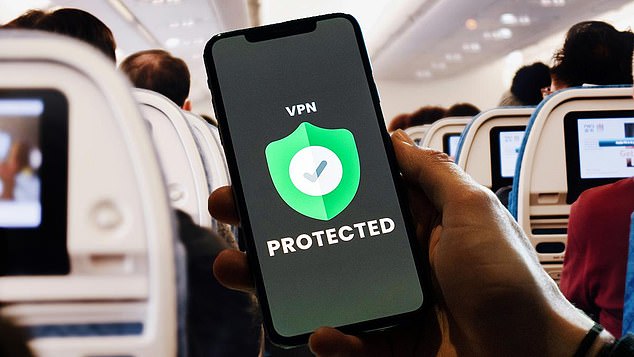Beware of hackers on a plane: Technology expert reveals the do’s and don’ts of using Wi-Fi in flight
- In-flight Wi-Fi can leave your devices open to hackers lurking in the shadows
- A tech expert shared tips like using VPNs that keep your device private
- Stay tech savvy with the free newsletter from expert Kim Komando, more than 500,000 people do so. Register here
Score! Your flight has Wi-Fi. But before you start shopping or do a quick check of your finances, you should know that hackers use sneaky tactics to hijack your privacy on the fly.
One thing in their favor: VPNs fall into the air more often than to the ground.
Without that layer of protection, cybercriminals using same-airline Wi-Fi can easily gain access to your devices, access your data, and spread malware.
Bad, bad news. Let’s break it down with a few do’s and don’ts to keep you safe.
Without that layer of protection, cybercriminals using same-airline Wi-Fi can easily gain access to your devices, access your data and spread malware
Make sure you are on the correct network
Most of us see a network name that looks good and click on it without much thought – and that’s what hackers are counting on.
Scammers can create fake Wi-Fi networks with almost identical names to those of the airline. If you’re not careful, you could connect to a copycat network instead of the legitimate network.
If several options are similar, ask an airline representative which network is correct. Hey, they can even give an on-air PSA if you see a fake.
Do use a VPN
As mentioned, a VPN (Virtual Private Network) isn’t as reliable on air, but it still works when it’s on.

One thing in their favor: VPNs fall into the air more often than to the ground
Normally what you do on the Internet is accessible to anyone with the right knowledge. A VPN encrypts your data and acts as a shield against prying eyes.
It is a must if you visit a site that contains financial or other identifying, important information. Do yourself a favor and make sure your VPN is active before logging in.
Stick to encrypted sites
This is always a good rule of thumb, but especially if you are on an unknown network. Only visit encrypted websites: websites that start with ‘HTTPS’.
That ‘S’ is important; it stands for safe.
This typically prevents a hacker from viewing your activities on a particular site, such as the password or credit card number you entered.
Do not download files
Let’s ignore the speed and data limits and focus on security here. Data transfer is possible on unsecured connections (such as those on your flight).
A hacker doesn’t have to work very hard to intercept the download and read everything in it.
No problem if it’s an audiobook. What about a bank statement or important work document?
It’s smart to download everything you need in advance before you head to the airport, or wait until you land and get to a trusted network.
